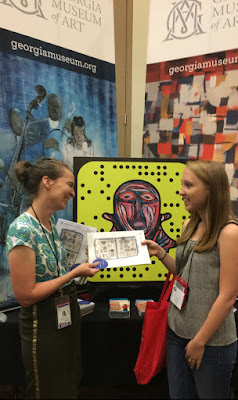With 60 artists and over 130 works, you might find yourself short on time or lacking direction; so we’ve put together this guided mini-tour of this extensive exhibition to help you make the most of your visit.
 |
| Pablo O'Higgins, Dos Mujeres, 1973 |
Continuing into the Rachel Cosby Conway Gallery, you’ll find many works by Mexican artist Rufino Tamayo. Luis Remba worked with Tamayo to create a process to show texture and depth. From this collaboration, Mixografia was born. Due to its sheer size, you won’t have any trouble noticing the work hanging on the center wall to your right: Tamayo’s “Dos Personajes Atacados por Perros” For the print, the workshop made the world's largest lithographic stone, which weighs more than four tons (a record it still holds).
Next, in the Alfred Heber Holbrook Gallery, if you look to your right you’ll see two large works by Helen Frankenthaler: “Guadeloupe” and “Hermes.” Frankenthaler was well known for her large abstract works, and she often used unconventional materials when applying her strong, flowing colors. For these, she used warm wax.
On the left wall of the Charles B. Presley Family Gallery, you’ll see a 3D work from French artist Arman. “To Garcia Lorca (Red)” was based on a model made by dismantling a guitar and reassembling them on a canvas in eccentric ways. Federico Garcia Lorca was a poet executed in Spain by fascist militia in the 1930s. Colored resin drips down the pieces of the instruments, emphasizing the 3D effects and recalling the blood spilled by the firing squad.
The Lamar Dodd Gallery leads you to its left wall where you’ll see Karel Appel’s “The Cry.” While Mixografia specializes in paper prints, they also make sculptural multiples like Appel's cast metal sculpture here. Appel moved to making sculpture in the latter part of his career. Prior to this time, Appel was known for rejecting conventional ideas about art and creating paintings that were colorful and abstract. “The Cry” features unusual materials cast in copper and bronze, with some items tipped in glowing red.
 |
| John Baldessari, Stonehenge (With Two Persons) Yellow, 2005 |
The last space, the Virginia and Alfred Kennedy Gallery, showcases Ed Ruscha and John Baldessari, two big names in contemporary art and longtime collaborators with Mixografia. On the wall to the left hangs Ed Ruscha’s “Ghost Station,” a revision of his popular work “Standard Station.” “Ghost Station” uses the same composition of “Standard Station” but with raised shapes instead of color, to create a more haunting effect.
Past the temporary wall and to the right, you’ll see the “Stonehenge” series from artist John Baldessari, which uses his trademark dots over the faces of people. By covering the faces, Baldessari takes away the individuality of each person and renders them as indistinct units of a crowd or group. Here, the work is duplicated six times with varying colors of dots and a contrasting colored Stonehenge in the background. Each of the six versions also has a different arrangement of depths.
This guided mini-tour ends with the “Stonehenge” series and we hope you enjoyed the highlights from this exhibition. An accompanying catalogue, published by the museum, can be purchased in the Museum Shop or by phone at 706.542.0450.
Benjamin Thrash
Publications Intern




